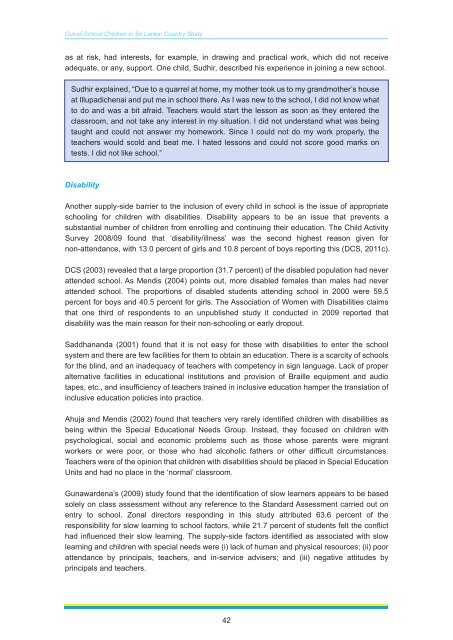Sri Lanka - Institut de statistique de l'Unesco
Sri Lanka - Institut de statistique de l'Unesco
Sri Lanka - Institut de statistique de l'Unesco
Create successful ePaper yourself
Turn your PDF publications into a flip-book with our unique Google optimized e-Paper software.
Out-of-School Children in <strong>Sri</strong> <strong>Lanka</strong>: Country Study<br />
as at risk, had interests, for example, in drawing and practical work, which did not receive<br />
a<strong>de</strong>quate, or any, support. One child, Sudhir, <strong>de</strong>scribed his experience in joining a new school.<br />
Sudhir explained, “Due to a quarrel at home, my mother took us to my grandmother’s house<br />
at Illupadichenai and put me in school there. As I was new to the school, I did not know what<br />
to do and was a bit afraid. Teachers would start the lesson as soon as they entered the<br />
classroom, and not take any interest in my situation. I did not un<strong>de</strong>rstand what was being<br />
taught and could not answer my homework. Since I could not do my work properly, the<br />
teachers would scold and beat me. I hated lessons and could not score good marks on<br />
tests. I did not like school.”<br />
Disability<br />
Another supply-si<strong>de</strong> barrier to the inclusion of every child in school is the issue of appropriate<br />
schooling for children with disabilities. Disability appears to be an issue that prevents a<br />
substantial number of children from enrolling and continuing their education. The Child Activity<br />
Survey 2008/09 found that ‘disability/illness’ was the second highest reason given for<br />
non-attendance, with 13.0 percent of girls and 10.8 percent of boys reporting this (DCS, 2011c).<br />
DCS (2003) revealed that a large proportion (31.7 percent) of the disabled population had never<br />
atten<strong>de</strong>d school. As Mendis (2004) points out, more disabled females than males had never<br />
atten<strong>de</strong>d school. The proportions of disabled stu<strong>de</strong>nts attending school in 2000 were 59.5<br />
percent for boys and 40.5 percent for girls. The Association of Women with Disabilities claims<br />
that one third of respon<strong>de</strong>nts to an unpublished study it conducted in 2009 reported that<br />
disability was the main reason for their non-schooling or early dropout.<br />
Saddhananda (2001) found that it is not easy for those with disabilities to enter the school<br />
system and there are few facilities for them to obtain an education. There is a scarcity of schools<br />
for the blind, and an ina<strong>de</strong>quacy of teachers with competency in sign language. Lack of proper<br />
alternative facilities in educational institutions and provision of Braille equipment and audio<br />
tapes, etc., and insufficiency of teachers trained in inclusive education hamper the translation of<br />
inclusive education policies into practice.<br />
Ahuja and Mendis (2002) found that teachers very rarely i<strong>de</strong>ntified children with disabilities as<br />
being within the Special Educational Needs Group. Instead, they focused on children with<br />
psychological, social and economic problems such as those whose parents were migrant<br />
workers or were poor, or those who had alcoholic fathers or other difficult circumstances.<br />
Teachers were of the opinion that children with disabilities should be placed in Special Education<br />
Units and had no place in the ‘normal’ classroom.<br />
Gunawar<strong>de</strong>na’s (2009) study found that the i<strong>de</strong>ntification of slow learners appears to be based<br />
solely on class assessment without any reference to the Standard Assessment carried out on<br />
entry to school. Zonal directors responding in this study attributed 63.6 percent of the<br />
responsibility for slow learning to school factors, while 21.7 percent of stu<strong>de</strong>nts felt the conflict<br />
had influenced their slow learning. The supply-si<strong>de</strong> factors i<strong>de</strong>ntified as associated with slow<br />
learning and children with special needs were (i) lack of human and physical resources; (ii) poor<br />
attendance by principals, teachers, and in-service advisers; and (iii) negative attitu<strong>de</strong>s by<br />
principals and teachers.<br />
42

















